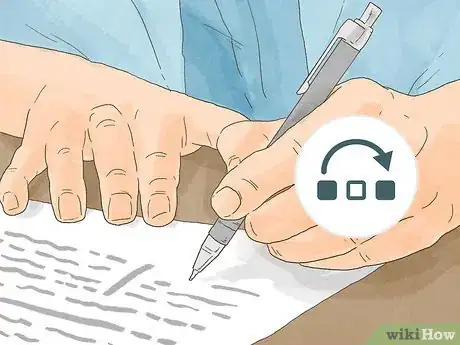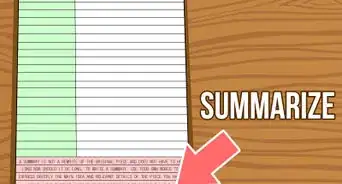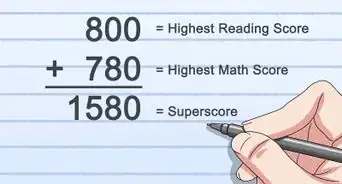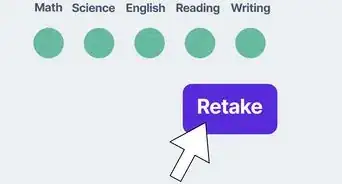This article was co-authored by Arash Fayz. Arash Fayz is the Co-Founder and Executive Director of LA Tutors 123, an academic consulting and private tutoring company based in Los Angeles, California. Arash has over 10 years of educational consulting experience, managing the tutoring of students of all ages, abilities, and backgrounds to score higher on standardized tests and gain admission to their target schools. He has a BA in Applied Mathematics and Computer Science from the University of California, Los Angeles.
There are 9 references cited in this article, which can be found at the bottom of the page.
wikiHow marks an article as reader-approved once it receives enough positive feedback. In this case, several readers have written to tell us that this article was helpful to them, earning it our reader-approved status.
This article has been viewed 341,383 times.
Doing well on the SAT is an important step toward getting into a good college. And there are so many easy ways to maximize your potential, like by focusing on the subject areas you struggle with during test preparations. Then give yourself the best possible start on test day by being well rested and fed. Finally, use test-taking strategies to help you manage your time wisely and move through the test in a way that plays to your strengths.
But if your test scores aren’t what you’d like them to be, that doesn’t mean you have to give up on your dreams.
Steps
Prepping for the Test
-
1Focus on the subjects you struggle with. Once you know what types of questions bring your scores down, focus your time and energy on these specific subjects. Buy a test-prep book or check one out from the library, and do 20 questions a night that are just like the ones you got wrong.[1]
-
2Set small goals. You may have a specific score in mind that you want to achieve eventually. But you need to figure out some small, realistic steps to take right now. If you’re doing 20 questions a night, aim to get 15 of them right. Once you’ve managed that, aim to get 17 of them right.[2]
- Rather than trying to learn every vocabulary word in the book, focus on learning prefixes and suffixes. These will help you understand more vocab words later on.
- If you struggle with the essay portion, set a timer and practice trying to write an outline in under five minutes.
Advertisement -
3Sign up for a test-prep class if you can afford it. If you have trouble studying on your own, sign up for a test-prep class. Ask your guidance counselor about any classes offered through your school. If your family can afford it, sign up through a service such as the Princeton Review. For more one-on-one attention, contact a test-prep company and ask about private tutors.[3]
-
4Organize a study group if you're on a budget. Test-prep classes can be too expensive for many families. If you're on a budget, gather some friends or classmates to create a study group that meets after school once or twice a week. Ask one of your teachers if they'd be willing to lead some sessions, or use a test-prep book as a guide.
- Study groups may be helpful for those in test-prep courses as well.
-
5Memorize the general test instructions. It’s important to follow the instructions printed at the beginning of the SAT, but they can take a long time to read. And they don’t change from test to test, so memorize them as part of your test prep. Know what’s expected of you for filling out your answer sheet (i.e. using a #2 pencil, filling in the bubbles neatly, etc.).[4]
- This will save you time on test day and could buy you an extra couple of minutes for answering questions.
-
6Take practice tests. The SAT follows the same format every year, so you can do better by simply practicing taking the entire test. Mimic the test environment by closing yourself in a quiet room and asking your family not to bother you. Set a timer, silence your phone, and take the practice test at the back of your test-prep book.
- Additional practice tests can be found online, though you may need to pay for them.
- If you don’t trust yourself to focus for the full amount of time, ask one of your parents to act as the test moderator and sit in the room quietly while you work.
Using Test-Taking Strategies
-
1Wear a watch. Most test centers will have a clock in the room, but you may not be able to see it easily. Find a reliable watch that you can wear during the test to keep track of how much time you’re spending on questions. You won't be allowed to have your phone out, so get an actual wristwatch.[5]
-
2Answer the questions that are easiest for you first. The SAT tends to have easier questions at the beginning and harder questions toward the end. But that doesn’t mean that what’s easy for everyone else is easy for you. Skip through the test and answer the questions you know you’re good at, then return to the beginning and work your way through everything else.[6]
- Be very careful about marking the appropriate spot on the answer sheet if you’re not going in order. Glance between the question number and the answer number before marking anything to make sure it matches.
-
3Make educated guesses for answers you don’t know. The SAT grading system used to deduct more points for a wrong answer than for an answer left blank, but that’s no longer the case. Blank answers and wrong answers are deducted equally now. So if you don’t know an answer on a multiple choice question, eliminate answers you know are wrong. Then guess between the choices you have left.
- If you’re waffling between two possible answers, defer to the one that was your gut reaction when you first read the question. Your instincts are often right, so employ them if you’re going to guess anyway.[7]
-
4Ration your time wisely. Typically, you shouldn’t spend more than one to two minutes on a question. If you’re working through a difficult question and notice that you’ve spent more than two minutes on it, circle it and move on. Then come back to it later if there’s time.[8]
- Be careful not to rush through the test. You don't want to make careless mistakes because you were rushing and not carefully reading the questions.[9]
-
5Write neatly on your answer sheet. Take the time to mark your answers neatly on the answer sheet and fill in bubbles fully. When the machine is grading the test later, it won’t be able to interpret what a stray pencil mark means, so it may mark the question wrong.[10]
-
6Track your progress on the test booklet. You can write on your test booklet, so make clear marks or notes for yourself to track your progress. Circle questions you skipped entirely, and make marks next to any you guessed on but want to come back to if there’s time.[11]
- They also provide scrap paper, so use this to work out any math problems. Write the question number beside the work in case you want to come back to it later.
-
7Read the questions before reading long passages. If you're not a fast reader, you won’t have time to read a passage, look at the questions, then read the passage again. For long passages that are more than just a few lines, skim the questions first. Then underline any information that may help you answer them as you read the passage.[12]
-
8Write a four-paragraph essay if you write slowly. The typical SAT essay follows a five-paragraph format: the introduction, three body paragraphs, and the conclusion. While the intro and conclusion are crucial, there is no rule that you have to have three body paragraphs. What matters is having well-developed paragraphs, so if you’re a slow writer, consider dropping the third body paragraph and writing a four-paragraph essay.
- Make your two body paragraphs more well-developed by backing up your claims with several examples from the text.
- Aim for a length of about 2 to 2.5 pages total, but don't fill the pages with overly long quotations from the passage or large handwriting. Test graders will see through this.
Preparing Physically
-
1Get plenty of sleep the night before the test. While you may be tempted to stay up late and cram in extra studying the night before the test, this could negatively impact your score. Aim to get at least eight hours of sleep the night before the test so that you’re well-rested and better able to focus in the morning.[13]
- If you're having trouble falling asleep the night before the test, direct your mind away from racing thoughts. Picture something relaxing, like lying in a hammock, then gradually fill in the rest of the imagery and details.[14]
- Try reading a good book (not a test-prep book) for 30 minutes to calm yourself down enough to fall asleep.
-
2Eat a protein-packed breakfast on the morning of test day. Even if you don’t normally eat breakfast, it’s important to do so on test day. This will minimize your chances of being distracted by hunger. Eat foods with lots of protein, such as eggs, sausage or bacon, and Greek yogurt. Add some whole-grain toast to keep you full longer.
- There are a couple of short breaks during the test. Take a granola bar or bag of almonds with you to snack on during these breaks to help keep yourself focused.[15]
-
3Exercise on the day before or morning of test day. Exercise can help de-stress you, so find some time to fit it in on the day before the test. Go for a run or a swim, or do yoga. You could also start test day with a brisk walk just to get your blood flowing.
Community Q&A
-
QuestionHow do I prepare on SAT day?
 Community AnswerMake sure you've eaten, had time to wake up properly, and exercise if you have time before the test. It doesn't have to be a work out, but getting your blood pumping will help you perform better and calm your nerves.
Community AnswerMake sure you've eaten, had time to wake up properly, and exercise if you have time before the test. It doesn't have to be a work out, but getting your blood pumping will help you perform better and calm your nerves. -
QuestionWhat can I do to improve in grammar with my SATs scheduled for tomorrow?
 Community AnswerLook for online tests on grammar specifically for the SATs, and do those tests as many times as you can.
Community AnswerLook for online tests on grammar specifically for the SATs, and do those tests as many times as you can. -
QuestionIs it about passing or failing?
 Community AnswerThere is no failing grade for the SATs. However, the better your score, the more college options you will have.
Community AnswerThere is no failing grade for the SATs. However, the better your score, the more college options you will have.
References
- ↑ https://www.greatschools.org/gk/articles/improving-sat-scores/
- ↑ https://www.greatschools.org/gk/articles/improving-sat-scores/
- ↑ https://www.usnews.com/education/blogs/the-college-solution/2011/01/18/7-ways-to-improve-sat-and-act-scores
- ↑ http://www.educationcorner.com/sat-test-taking-tips.html
- ↑ https://collegereadiness.collegeboard.org/sat-subject-tests/taking-the-test/test-day
- ↑ https://www.thoughtco.com/break-these-rules-to-improve-sat-scores-3211466
- ↑ http://www.educationcorner.com/sat-test-taking-tips.html
- ↑ http://www.educationcorner.com/sat-test-taking-tips.html
- ↑ Jennifer Kaifesh. Test Prep Tutor. Expert Interview. 8 November 2019.
- ↑ http://www.educationcorner.com/sat-test-taking-tips.html
- ↑ https://collegereadiness.collegeboard.org/sat-subject-tests/taking-the-test/test-taking-tips
- ↑ http://www.educationcorner.com/sat-test-taking-tips.html
- ↑ Arash Fayz. SAT Prep Tutor. Expert Interview. 1 November 2019.
- ↑ http://kidshealth.org/en/teens/sleepless.html?ref=search&WT.ac=msh-t-dtop-en-search-clk
- ↑ https://collegereadiness.collegeboard.org/sat-subject-tests/taking-the-test/test-day
- ↑ Jennifer Kaifesh. Test Prep Tutor. Expert Interview. 8 November 2019.
About This Article
Doing well on the SAT can be tough, but you can ace it if you take time to prepare well. If you’ve taken the test before, review your previous scores to figure out your strengths and weaknesses. As you study, focus on the areas where you struggle the most. For instance, if you did well overall but got a low score on the writing and language section, spend most of your time studying those subjects. To keep from feeling too overwhelmed, break your studying down into smaller goals. For instance, set a goal to work through 20 math problems a night and get at least 15 of them right. If you struggle to study on your own, consider taking a test prep class or forming a study group with friends. Practice will make a huge difference, so take as many practice tests as you can. For expert advice on strategies you can use while taking the test, read on!













































































